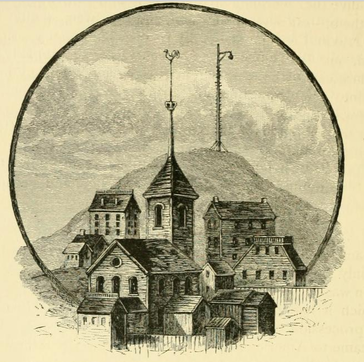KING'S CHAPEL
 19th-century illustration depicting the original King's Chapel
19th-century illustration depicting the original King's Chapel
Before the construction of the current stone structure, King’s Chapel was a much smaller, wooden building located on the same site. When the congregation was founded in 1686, it had no permanent home and was relegated to what would become the Old State House by an unwelcoming Puritan populace. The wooden chapel opened to its congregation in 1689, but few written records of its appearance remain. Much of what we know about the wooden chapel comes from visual records, such as drawings and diagrams, that provide more imagery than dimensions.
Very few pieces of the wooden chapel are still in their original location. Between 1749 and 1754, the current stone chapel was built around the original wooden chapel, which would have fit between the columns of the Sanctuary, was dismantled and removed from inside. The materials from the wooden chapel were used to build another Anglican church: The Church of St. John in Nova Scotia. While St. John has lost much of its structure over time due to renovation and disaster, much can be learned about the wooden chapel by studying how it was rebuilt as another church.
Very few pieces of the wooden chapel are still in their original location. Between 1749 and 1754, the current stone chapel was built around the original wooden chapel, which would have fit between the columns of the Sanctuary, was dismantled and removed from inside. The materials from the wooden chapel were used to build another Anglican church: The Church of St. John in Nova Scotia. While St. John has lost much of its structure over time due to renovation and disaster, much can be learned about the wooden chapel by studying how it was rebuilt as another church.
Altarpieces

While the wooden chapel itself is no longer in Boston, some of its elements remain in the stone chapel. The panels that make up the altarpieces are the oldest items in the entire chapel, dating back to 1696. They contain the text of the Lord’s Prayer, the Ten Commandments, and the Apostle’s Creed. The Reverend Samuel Myles, the second minister of King’s Chapel, received the painted wood altarpieces and other gifts from King William. Pieces like these symbolized a strong endorsement from the crown upon the church.
The words on the panels feature what is called the “long s”, the old-fashioned letter “s” that looks like a lowercase “f”. It grew out of how Romans wrote the cursive lowercase s and was picked up by other European languages over time. Although it looks odd today to see “treſſpaſſes” in the Lord’s Prayer, it did not change the pronunciation. It was part of the English printing and handwriting style until the 19th century and is visible in several places in the chapel.
The words on the panels feature what is called the “long s”, the old-fashioned letter “s” that looks like a lowercase “f”. It grew out of how Romans wrote the cursive lowercase s and was picked up by other European languages over time. Although it looks odd today to see “treſſpaſſes” in the Lord’s Prayer, it did not change the pronunciation. It was part of the English printing and handwriting style until the 19th century and is visible in several places in the chapel.
The Pulpit
 King's Chapel pulpit, photographed by Sarah Farkas in 2019
King's Chapel pulpit, photographed by Sarah Farkas in 2019
Another element retained from the wooden chapel is the pulpit, which dates to 1717.
It is the oldest continuously used wooden pulpit at its original site in the United States at over 300 years old. Confirming that it predates the stone building, the earliest paint layers on the pulpit are older than that of the rest of the chapel, and was moved from the corner to its current location when the building was reconstructed. When it moved, decorative back panels and an acoustic sounding board were added and the pulpit was placed on a free-standing “wine glass” stand.
Ministers still ascend to the highest level during Sunday worship to deliver their sermons.
It is the oldest continuously used wooden pulpit at its original site in the United States at over 300 years old. Confirming that it predates the stone building, the earliest paint layers on the pulpit are older than that of the rest of the chapel, and was moved from the corner to its current location when the building was reconstructed. When it moved, decorative back panels and an acoustic sounding board were added and the pulpit was placed on a free-standing “wine glass” stand.
Ministers still ascend to the highest level during Sunday worship to deliver their sermons.
www.kings-chapel.org | 58 Tremont St. Boston, MA 02108 | 617-227-2155